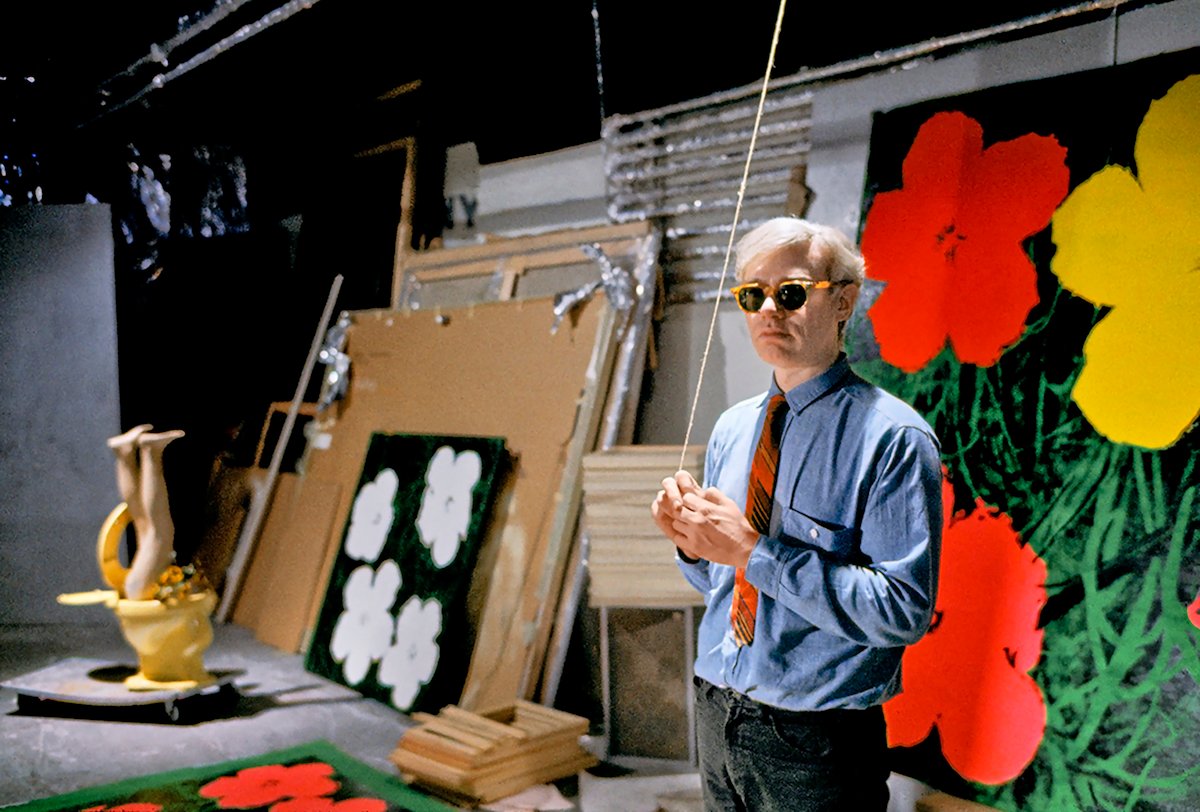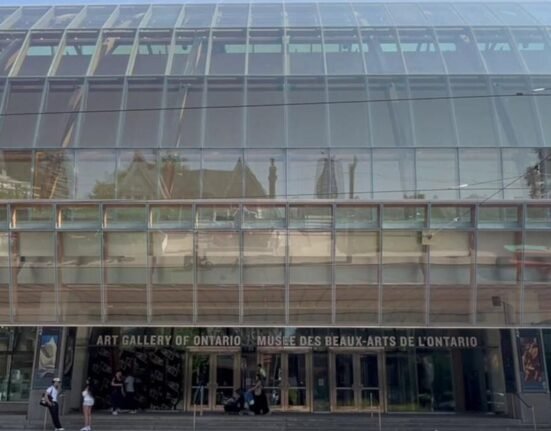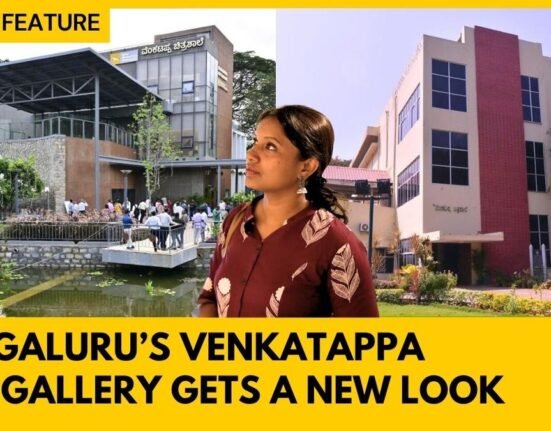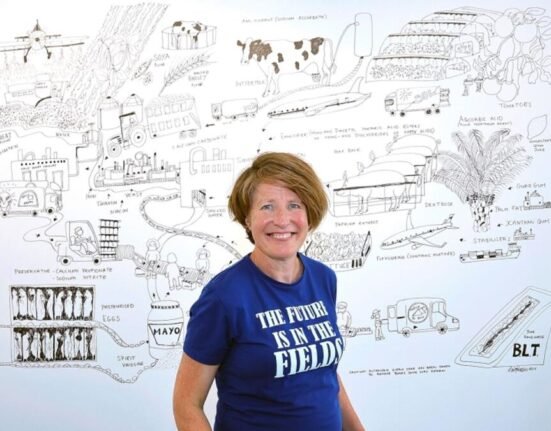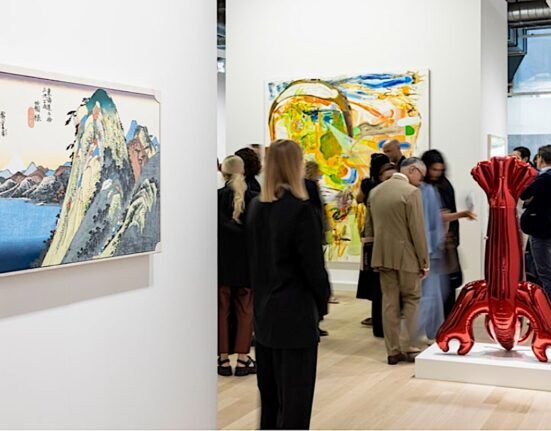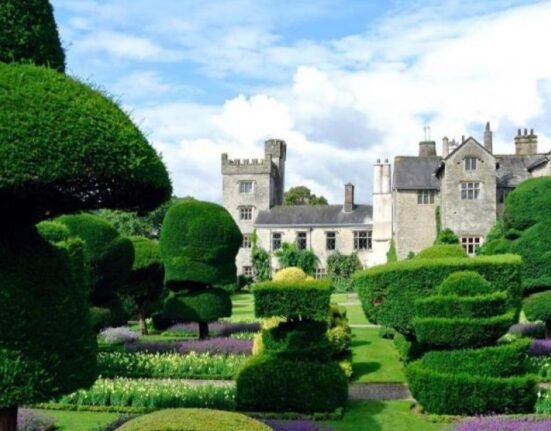For the June diary, I begin with two important recently published books about religion and contemporary art. Next, I highlight several exhibitions and artists whose work connects with the themes explored in these books. These include Anselm Kiefer, Vincent van Gogh and Andy Warhol, alongside plans for Manifesta 16 Ruhr. I conclude with group shows that engage with contemporary issues and explore, as the title of one exhibition puts it, ‘The Shape of Now’. These include two fascinating exhibitions which are local to me, in Essex, at Focal Point Gallery and Beecroft Art Gallery.
‘The Invisibility of Religion in Contemporary Art’ by Jonathan A. Anderson offers a critical guide for rereading and rethinking religion in the histories of modern and contemporary art. Since the turn of the twenty-first century, there has been a marked increase in attention to religion and spirituality in contemporary art among artists and scholars alike. Still, the resulting scholarship tends to be dispersed, disjointed, and underdeveloped, lacking a sustained discourse that holds up as both scholarship of art and scholarship of religion. ‘The Invisibility of Religion in Contemporary Art’ is both a critical study of this situation and an adjustment to it, offering a much-needed field guide to the current discourse of contemporary art and religion.
By connecting the work of leading art historians, theologians, philosophers, and sociologists, Anderson uncovers the gaps and reveals opportunities for scholars to engage more fully with the theological grammars, histories, and concepts at play in modern and contemporary art. By addressing the religious blind spots in existing scholarship, he opens new lines of inquiry and invites deeper dialogue among religious studies, theology, and art history and criticism.
Part I critically examines the period prior to the publication of James Elkins’ key text, ‘On the Strange Place of Religion in Contemporary Art’. Elkins’ book identifies the key issue addressed by Anderson’s book, which is “not a lack of religiously meaningful artworks but a lack of compelling, well-informed writing about artworks that ably engages the theological intelligibility of this work”. Part II reviews responses to the increased visibility of religion in art from the late twentieth century onwards and sets out some key frameworks for such responses. Part III then explores ways of writing well about contemporary art within a Theological Interpretive Horizon.
This book, which has already been called “a bombshell on the playground of the art historians and art critics”, sets out a compelling case for histories of modern and contemporary art “to be reread and rewritten in ways that understand religion and theology more seriously”. It effectively clears space for and reshapes the basis on which such work can and should be done in future.
The ‘Handbook of Theology and the Arts’, published by T&T Clark, presents the theology-arts conversation from a distinctly Christian perspective and is permeated by a widespread interest in the historical, socio-cultural, and political embeddedness of theology and the arts.
This theme of embeddedness tracks through several overarching and interlocking concerns: the relationship between form and content (in both art and theology), the intensification of the metaphysical and the theological (contra materialist and positivist reductionisms), the expansion of the epistemological possibilities of the theology-art conversation, and a robust understanding of the world as the theatre of God’s glory. Several chapters have been co-written by theologians and artists as part of demonstrating the kind of conversation that this book commends.
Part I surveys different approaches to the theology-arts conversation. Part II focuses on how particular art forms bring theological issues to the surface and how theological and denominational traditions shape the making and receiving of the arts. Part III delves into key topics in the current theology-arts scene, exploring how artistic and theological performance can both speak to theological and artistic knowing and help celebrate and interrogate embodied, lived reality.
Manifesta 16 Ruhr promises to be a biennial that engages with themes explored in these two books. This biennial will investigate how culture can inspire civic engagement and instigate positive social change through inclusive and participatory practices.
The Ruhr Area, with its rich industrial heritage, experienced widespread destruction during the Second World War due to its strategic significance as a centre of coal and steel production. In the post-war period, the region underwent rapid reconstruction, with new architectural and social models reshaping city centres and neighbourhoods. In preparation for Manifesta 16, the team organising the biennial has explored this history through the lens of urban transformation that played a central role in rebuilding neighbourhoods in the region.
A key feature of this research concerns the role of churches in the post-war reconstruction of the Ruhr Area. These buildings, often constructed by local communities, came to symbolise civic identity and democratic participation. Today, however, many of these churches face redundancy. In Germany alone, nearly half of the country’s 40,000 churches are expected to be closed, demolished, or sold within the next decade.
Manifesta 16 Ruhr will explore how these former places of worship might be repurposed as inclusive cultural and social spaces. By reimagining these vacant structures as sites for community gathering and artistic exchange, the biennial aims to promote intercultural dialogue and social cohesion—especially in response to current global tendencies of polarisation and nationalism.
Churches should not only be understood in isolation but in their relation to other cultural and symbolic heritage, as well as religious, social and welfare institutions. Historically, churches and other religious buildings have not only served spiritual purposes, but also acted as civic spaces — sites of gathering, exchange, and support within communities. From a civic and urban perspective, the church inherits the function of a public space from Roman basilicas and the Agora, which were centres of community life.
Drawing on this legacy, the Manifesta 16 Ruhr collaborative process seeks to explore the potential of these vacant neighbourhood axis points. Crucial for the public perception and political fruitfulness of the project will be a differentiated and extensive dialogue and collaboration with local actors and mediators from other religious communities, secular stakeholders and cultural initiatives, made by bridgebuilders who will have the trust of the communities. Manifesta 16 Ruhr’s appointed First Creative Mediator, Josep Bohigas is conducting holistic urban research on the relationship between houses of worship and their surroundings, focusing on their proximity and the sociospatial fragility of the adjacent neighbourhoods. His work aims to develop new perspectives on revitalising and regenerating these areas, positioning churches as central cultural catalysts. The Manifesta 16 Urban Vision is expected to be presented in June 2025.
The McDonald Agape Lecture in Theology and the Visual Arts 2025 will take place on 8 July 2025 at Inner Temple, London, and sees Genesis Tramaine and Emily Young in conversation with Christine Joynes.
US painter Genesis Tramaine is an expressionist devotional painter deeply inspired by biblical texts, whose work is held in permanent collections, including the National Gallery of Art in Washington DC. In last month’s Diary, I highlighted her current exhibition ‘Genesis Tramaine: Facing Giants’ at the Consortium Museum in Dijon. She has said of her practice, “I think the deeper I go into Genesis, the closer to myself I can get, I can get closer to God.” British sculptor Emily Young uses the beauty, history, and energy of stone to connect people to the natural world and has made many sculptures for ecclesiastical settings, including St Paul’s Churchyard and Salisbury Cathedral. They will be discussing their work with Dr Christine Joynes (University of Oxford), a leading scholar in the study of the Bible and the arts.
Emily Young’s sculpture, ‘The Sun King Dreams of Peace’, in Giallo di Siena stone, is currently on view in Berkeley Square, London. This monumental free-carved work illuminates the elegant garden square, its timeless beauty reminding visitors to connect more consciously with both their environment and fellow humans, as children of the planet. Her sculpture, ‘Warrior Poet’, has joined the permanent collection of the Victoria and Albert Museum and is on display in Room 21 in The Dorothy and Michael Hintze Galleries, alongside sculpture from the 4th century to the present day, with masterpieces by Michelangelo, Bernini and Rodin. A new exhibition of her work, ‘Comparative Stillness: Emily Young’ opens at Richard Green this month.
Young’s classical, contemporary heads are her most iconic works, combining powerful yet peaceful facial features with uncarved natural stone, each element enhancing the other, eloquently expressing both art and geological history. Her work is a beacon of hope for the future, bringing light, beauty and meaning into the world.

In ‘Andy Warhol: My True Story’ at Newlands House Gallery, a unique journey can be followed, which allows viewers to gain insight into the “real” Warhol: Through carefully selected Warhol drawings, artworks and artefacts together with previously unseen photographs by, and recordings with, his entourage and collaborators, this exhibition presents a more intimate and human side to Warhol as well as exposing some of the lesser known and enduring themes he explored in his art.
As visitors move through the exhibition, they grow to understand more about his family origins, his journey into the art world, and the people he surrounded himself with. They also see Warhol’s homage to art history, his drawings and screenprints, his love of repetition and his very particular way of composing his art. His powerful influence beyond the grave can also be viewed through the works of contemporary artists who have paid homage to Warhol and his enduring legacy.
Warhol asserted that if you wanted to know everything about him, you just had to look at his work; that he was all about ‘surface’. However, this was far from the truth: He was both a deeply private man who did not wish to be known and the public persona he created, with his wig, dark glasses, entourage, and celebrity party-going. As a result, the ‘behind the scenes’ perspective that this exhibition offers may be surprising to those more familiar with the universally recognisable ‘man in a fright wig’ with his Marilyns, soup cans and dollar signs.
In private, he remained very close to his mother, Julia, who lived with him and kept their Carpatho-Rusyn cultural heritage alive. As a result, Anderson has written in ‘The Invisibility of Religion in Contemporary Art’ that it has “become increasingly necessary to make sense of Andy Warhol’s work against the background(s) of his own Byzantine Catholic upbringing, his apparently serious but private Christian belief to the end of his life, and the history of Catholic iconography from which he repeatedly drew throughout his career”.
In public, Warhol hid behind soundbites and misleading and vague information, creating many versions of himself behind his smoke-and-mirrors facade. Claiming that he had always felt like an ‘outsider’, he was an inveterate observer, intensely curious about others and the world, ‘looking in’ on a public life he only really shared on the surface. It was these observations that fuelled his creativity, and his philosophical reflections on what he saw underpinned his work.
The exhibition’s curator, Professor Jean Wainwright, developed personal friendships with many members of Warhol’s family, his contemporaries, and the people he surrounded himself with at his Factories, interviewing them to elicit their stories about Warhol. Spending hundreds of hours in the 1990s listening through headphones to the now embargoed recordings Warhol made on the tape recorder that was his constant companion also allowed her to develop a peculiarly intimate relationship with Warhol himself.
Through the intertwining of Warhol’s artworks with photographs, objects, and artefacts, alongside films and reflective recordings with his relatives and contemporaries, this exhibition reveals not only an elusive and fascinating man but also the influence that he still exerts on artists and his prescience in conveying a culture of populism and consumerism.

Anselm Kiefer and Vincent Van Gogh are brought together in ‘Kiefer / Van Gogh’ at the Royal Academy. White Cube Mason’s Yard also has a solo exhibition of paintings by Kiefer to coincide with the RA’s exhibition.
Both are artists who engage with aspects of religion. In ‘At Eternity’s Gate: The Spiritual Vision of Vincent van Gogh’, Kathleen Powers Erickson traces Van Gogh’s pilgrimage of faith, from his early religious training, through his evangelical missionary period, to his struggle with religion and modern thought, and finally to the synthesis of traditional Christian beliefs with the modern world-view that she contends he achieved in both his life and his art. Kiefer’s work often elaborates on themes of loss, history, and redemption and shows the ability of creative work to traverse between the earthly and the divine. His work navigates the immensity of history and visions of humanity, as, for him, the constructed linearity of history is a fiction where traditions, beliefs and mythologies intertwine in its making.
In 1890, Van Gogh painted his final works, and seventy-two years later, the eighteen-year-old Kiefer received a travel grant to follow in Van Gogh’s footsteps, starting in the Netherlands, through to Belgium, Paris and Arles in the south of France. Van Gogh has had an enduring influence on Kiefer, and this exhibition is the first to consider this influence. The pioneer of Post-Impressionism has informed the subjects and techniques of Kiefer’s monumental paintings and sculptures, which draw on history, mythology, literature, philosophy and science. The exhibition features work by both artists, including new pieces by Kiefer which haven’t been shown before.

Highlights of the exhibition include a selection of Kiefer’s celebrated large-scale landscapes, including ‘Die Krähen’ (‘The Crows’) and ‘Nevermore’. These monumental works clearly encapsulate Kiefer’s admiration for the compositional devices used by Van Gogh, as evidenced by his adoption of high horizon lines, close-up imagery combined with deep perspectives, and panoramic formats. They also reflect shared motifs of crows and wheatfields and a deep affinity towards painterly surface textures. The exhibition also features drawings by both artists. The drawings Kiefer produced in his youth, inspired by Van Gogh during his journey in his footsteps, are presented alongside several of Van Gogh’s own drawings.
Further highlights include ‘Walther von der Vogelweide: under der Linden an der Heide’ (‘Walther von der Vogelweide: under the Lime Tree on the Heather’), a recent work by Kiefer, which has never been exhibited before, and a new sculpture created for the exhibition, depicting a tall sunflower emerging from a large pile of books, shedding golden seeds onto their lead pages. The sculpture is shown in dialogue with Van Gogh’s ‘Piles of French Novels’ and visualises the importance of literature and poetry to both artists; Van Gogh was one of the most well-read artists of the 19th century, and Kiefer makes words and literary references visually present in his work. Lastly, ‘De Sterrennacht’ (‘The Starry Night’), a monumental canvas of straw, gold leaf, and sediment from electrolysis by Kiefer, leaves visitors with a lasting impression of his resounding admiration of Van Gogh through his interpretation of the iconic ‘Starry Night’.
Egbert Modderman and Neil Tye are two artists specifically engaging with themes of faith in their work. Modderman is an artist whose monumental paintings featuring figurative representations are inspired by biblical stories. The City Museum Harderwijk is presenting his first solo museum exhibition in the Netherlands. The exhibition provides an overview of the impressive and idiosyncratic oeuvre that Modderman has built up over the past ten years. In his work, Modderman emphasises the human emotions in Christian stories and the universal expressiveness that they express. In doing so, he makes the age-old stories recognisable and tangible for a contemporary audience.
Born in Groningen in 1989, after completing his studies, he decided to focus on universal themes of meaning on large canvases that people would not pass by in a museum. Despite limited experience, he became the permanent painter of the Martini Church in Groningen from 2015. When he wanted to rent the church for an occasion, he, in return, painted a contemporary portrait of Saint Martin, after whom the church was named. The Martinikerk Groningen Foundation and the public were so enthusiastic that an exhibition of ten major works followed in 2016. In 2020, Modderman won the BP Young Artist Award with his portrait ‘Rusteloos’, and in 2024, he was named ‘Talent of the Year 2025’ by Stichting Kunstweek.
Tye is a Denmark-based artist with a background in both visual arts and physical theatre. Drawing from his multi-disciplinary background, his work explores movement, form, and storytelling through visual mediums. His practice is grounded in an intuitive and process-driven approach, wherein the act of painting itself dictates the final composition. By embracing spontaneity and fluidity, his work exists at the intersection of abstraction and interpretation, inviting viewers to engage with the imagery in a way that is both personal and open-ended. Through this interplay between process and meaning-making, his paintings function as both intuitive expressions and conceptual explorations of movement, memory, and transformation.
He has explained that the title of his current exhibition, ‘The Things We Carry’: “was inspired by reflections I had while creating my recent body of work. The first thought centres on the fundamental nature of human connection—we are not meant to navigate life alone. We rely on one another for support, understanding, and encouragement, whether through conversation, shared experiences, or emotional upliftment. The second thought arose from one particular painting, which evoked the image of an overloaded truck. This visual metaphor led me to consider how, in life, we accumulate and carry various burdens—emotions, worries, frustrations, memories, secrets, hopes, and dreams. These intangible yet weighty elements can become overwhelming, making it evident that we cannot bear them alone. At times, we must find ways to release or share these burdens, but this raises important questions: Where do we turn for relief? To whom do we entrust our heaviest thoughts? And how can we cultivate a sense of communal support to help lighten the loads we all inevitably carry?”
Moving on to group shows exploring contemporary issues, GRIMM has an exhibition inspired by ‘The Garden of Earthly Delights’ by Hieronymus Bosch. The exhibition hinges around the ideas of natural beauty, pleasure, and our environment by responding to the bucolic beauty of Eden, the surreal madness of hell, and the suspended time before humanity. ‘The Garden of Earthly Delights’ brings together a group of artists who reflect not only on nature’s forms but also on the moments between the real and the imagined. Some artists ruminate on the original work in the abstract, while others use known forms to connect these ideas to today.
‘The Shape of Now’ at Zari Gallery brings together nine international artists whose work challenges, reflects, and reshapes our perception of the present moment. Through painting, sculpture, mixed media, and digital forms, the exhibition explores how contemporary artists interpret identity, landscape, form, and emotion in a constantly shifting world.
Each artist offers a unique visual language — some poetic and abstract, others bold and narrative — but all are united by an urgency to capture what it means to exist in the now. Artist, illustrator, author and musician Maurizio Galia, for example, works among Metaphysical and Magic Realism atmospheres, looking at the heritage of the Italian and European Renaissance to explore the endless possibilities of artistic expression.
From the architectural to the organic, the figurative to the conceptual, the exhibition weaves a dialogue between individual expression and collective experience. ‘The Shape of Now’ aims to be more than an exhibition, looking to be a snapshot of the contemporary condition, a reflection of artistic voices responding to a world in flux.
‘Looking at Her’ is an exhibition that explores portraiture and how artists turn to the figurative and the fictitious in their expansive depictions of women. Portraits of writers, poets and activists sit alongside speculative imaginings of interior worlds to explore women’s lives, for instance, through domestic spaces and diary entries. How women are seen and how they see themselves runs through several of the works. The leitmotif of the mirror, an object intrinsic to our appearance and subjectivity, prompts us to think about the inherent multiplicity of the self and how others perceive us.
The title of the exhibition is taken from the sculptural work by the artist Trupti Patel. This totem-like ceramic column holds separate niches containing her different body parts, such as breasts, hands and knees. Inside the sculpture is a small mirror and a lock of the artist’s hair. The viewer is encouraged to peer inside the sculpture, turning the act of viewing from one of looking at to one of looking in. For some artists, the focus is less on a specific person depicted in figurative form but rather on the network of connections, conversations, and encounters that surround them. What do we ‘see’ when we look at her? And what happens when our gaze is expressly directed towards women’s lives as opposed to how they look?
All the works in this exhibition are from The Women’s Art Collection or are on a long-term loan. In looking at the work of women artists, such as Eileen Agar, Felicity Allen, Nicky Bird, Eva Frankfurther, Margaret Harrison, Sadie Lee, Linder, and France-Lise McGurn, among others in this exhibition, we start to comprehend the myriad ways that artists wrestle with the experience of being in the world, both corporeally and spiritually.
Shape Arts has brought its landmark ‘Crip Arte Spazio: The Disability Arts Movement in Venice’ exhibition to Leicester, fresh from its presentation at the Venice Biennale 2024. The Disability Arts Movement [DAM] aligned art with the fight for rights, broke barriers and ultimately affected changes in UK law while making great art about doing so. This exhibition is a joyous and exuberant celebration of the DAM, showcasing its dynamism, wit, and grandeur.
The exhibition reclaims historical slurs ‘Crip Arte Spazio’ in an unflinching explosion of huge protest banners, cartoon panels, large-scale projected artist films, photography, graphic novels, and campaign merchandise featuring artists Keith Armstrong (supported by the National Disability Movement Archive and Collection), Terence Birch, Tony Heaton OBE, Jameisha Prescod, Abi Palmer, Ker Wallwork, Tanya Raabe-Webber and Jason Wilsher-Mills. Attenborough Arts Centre is the first UK touring venue for this historically important show.
Two group shows are located locally to me, at Southend-on-Sea. Focal Point Gallery presents ‘In Other Worlds: Acts of Translation’, an exhibition developed in collaboration with the Roberts Institute of Art. The exhibition brings together over 15 works, some of which have never been shown in a public gallery before, from the David and Indrė Roberts Collection, one of the UK’s foremost private collections. The exhibition engages with the theme of translation – through storytelling and myth, history and memory, language and materiality – and features a newly commissioned installation and performance by Haroon Mirza.
The exhibition considers translation as an act of movement and transformation. At a time when anything can seem open to interpretation, yet nothing appears to hold, the exhibition asks: how do we engage with multiple perspectives without collapsing into relativism? How can we communicate across distances while still recognising differences? How do we engage with others – people, histories, ideas – without assuming full knowledge or easy equivalence? The works in the exhibition show that to translate is not only to carry something across (the root meaning of the word) but also to expose its limits, its gaps and its generative possibilities. Translation is always partial, always unfinished, and in never being complete, it offers an ongoing commitment to the world and others.
Mirza’s sound commission explores translation through sound, rhythm, performance and communal participation. His work translates binary code into the infinite variety of the human voice, revealing how even the most structured systems remain open to interpretation. By weaving together voices from the local community, Mirza’s installation makes translation a live and participatory process, one that engages difference rather than erasing it.
Translation shapes how we engage with the past, how we navigate inherited narratives and how we attempt to understand one another. Anselm Kiefer, Michael Armitage, George Condo and Ellen Gallagher, amongst others, explore how myths and stories shift with each retelling. Their works invite us to reconsider how stories, from oral traditions to the Bible, are continually reshaped, revealing that meaning is never fixed but always in flux. Other artists, including Nika Neelova and Louise Bourgeois, consider translation as a way of engaging with history, memory and loss.
Beyond stories and history, the exhibition questions the limits of language itself, looking at how experiences can never be fully captured. Pierre Huyghe, Antoni Tàpies, Simon Fujiwara, and others explore moments where gaps in understanding become spaces for invention. Artists such as Romany Eveleigh and David Birkin extend this beyond words, revealing how meaning moves through gesture, rhythm, and touch – forms of communication that exist outside dominant linguistic structures.
In an era of misinformation, contested histories, and unstable narratives, this exhibition reminds us that translation is never neutral. It is an active, interpretive process that shapes how we relate to the past, to others and the world around us. As the artists in this exhibition show, to translate is to commit to the world and one another, even and especially in the face of uncertainty.
To mark the tenth anniversary of the Thames Group, the Beecroft Gallery is hosting ‘The Scene by the Sea’, an exhibition that celebrates Southend’s rich and rebellious pop cultural heritage. Inspired by the fold-out map conceived by author/musician Will Birch, artist and former ‘Clash’ right-hand man Kosmo Vinyl, together with graphic artist Jules Balme, this show charts the clubs, record shops, fashion boutiques and music venues that once made the town a creative epicentre by the estuary.
The Thames Group artists respond with new work that is both playful and poignant, capturing the spirit of a scene that continues to echo along the seafront and through the generations. Their multi-disciplinary exhibition features work by over 30 artists and special guests, including Billy Bragg, Phill Jupitus, Wilko Johnson, Ian Dury, Vivian Stanshall, and more. Artists such as renowned painter Simon Monk, award-winning sculptor Anne Schwegmann-Fielding, portrait painter Victoria Sills, photographer Dean Chalkley, and assemblage artist Catriona Faulkner have all responded to locations plotted on the fold-out map. Ceramicist Richard Baxter has also recreated a few iconic venues as porcelain flatbacks. The map and resulting exhibition are an exploration of many of the hippest clubs, pubs, discotheques, dancehalls, coffee bars, music shops and fashion boutiques that were pivotal in helping to create Southend’s rich pop culture heritage.
Lead image: Bob Adelman, Andy Warhol at the Factory with ‘Flower’ paintings, 1964 © Bob Adelman Estate. Courtesy the Bob Adelman Estate and Westwood Gallery NYC.
‘The Invisibility of Religion in Contemporary Art’ by Jonathan A. Anderson, Notre Dame Press, 2025 – Visit Here
‘T&T Clark Handbook of Theology and the Arts’, Bloomsbury, 2025 – Visit Here
Manifesta 16 Ruhr – Visit Here
McDonald Agape Lecture in Theology and the Visual Arts 2025, 8 July 2025, Inner Temple, London – Visit Here
‘Comparative Stillness: Emily Young’, Opening 18 June 2025, Richard Green – Visit Here
‘Andy Warhol: My True Story’, 6 June – 14 September 2025, Newlands House Gallery – Visit Here
‘Kiefer / Van Gogh’, 28 June – 26 October 2025, Royal Academy – Visit Here
‘Anselm Kiefer’, 25 June – 16 August 2025, White Cube Mason’s Yard –
‘Egbert Modderman’, 13 April – 21 September 2025, The City Museum Harderwijk – Visit Here
‘Neil Tye: “The Things We Carry”‘, 7 June – 28 June 2025, Redbud Arts Center, Houston – Visit Here
‘The Garden of Earthly Delights’, group exhibition, 27 June – 8 August 2025, GRIMM, New York – Visit Here
‘The Shape of Now’, 5 – 18 June 2025, Zari Gallery – Visit Here
‘Looking at Her’, 3 May – 7 September 2025, The Women’s Art Collection, Murray Edwards College – Visit Here
‘Crip Arte Spazio: The Disability Arts Movement in Venice’, 14 February – 22 June 2025, Attenborough Arts Centre – Visit Here
‘In Other Worlds: Acts of Translation’, 21 June – 13 September 2025, Focal Point Gallery – Visit Here
The Thames Group of Artists Present’ The Scene by the Sea’, 24 May – 26 October 2025, Beecroft Art Gallery – Visit Here

